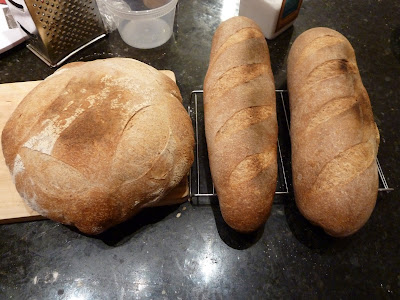These breads are all from Daniel Leader's Local Breads, which has a ton of great anecdotes and really interesting breads which I can't wait to try. I need to source some good rye flour.
The first bread I tried from the book was a basic pain au levain, what Leader calls the "quintessential French sourdough." The recipe calls for 6% rye flour, 24% stone ground whole wheat and 70% bread flour. I just did 70/30 bread flour and whole wheat flour in the absence of rye. Leader doesn't call for retarding the dough in the fridge overnight (French sourdough has very little sourness, and longer fermentation causes more acid to be produced by the lactobacillus bacteria in the sourdough), but I did anyway, mostly because of timing issues.
I can thank Leader for the tip about wetting the lame before scoring. Here it is:
And the batards, ready for the oven. I think they could have proofed a bit longer, but it was already midnight. Parchment paper is very convenient.
In the oven:There's the oven spring. You can see the batard on the left already rupturing.
And the finished bread.
Beautiful crust.
There are a bunch of awesome looking rye breads in the book, but I still don't have any rye flour. In the meantime, buckwheat batards caught my eye. The bread is based on an original loaf made by Eric Kayser at his Paris boulangerie called the Paline. I don't think I had ever had buckwheat bread, though I really like soba and galettes - both of which I would like to try to make. Also, if anyone wants to buy me some caviar, I'll bring the blini and creme fraiche.
The bread is made with a liquid levain - a very wet sourdough starter invented by Kayser - which I approximated by feeding my starter with extra water. The dough is about 15% buckwheat, which gives it plenty of flavor. For the remainder I used a mix of King Arthur high gluten and bread flour.
Ready for the oven:
Pretty good spring:
The last loaf I baked, also out of Leader's book, was a whole wheat sourdough miche. The dough is made with about 85% whole wheat flour and 15% bread flour. It's a very wet dough, at 75% hydration, and it took a lot of kneading to get it to come together and pass the windowpane test. But it was worth it.
Fairly dense, but perfectly chewy crumb.
I also made a walnut bread loaf with about 1/3 of the dough. It didn't rise as well, but I'm glad I tried it.
Not pictured is a spray bottle that I use to spray water all over the oven and loaves as they go in. I think this method of generating steam has really helped with the oven spring.
What I still need is a stand mixer. There are some amazing looking Italian breads in the book that are apparently too wet to even bother trying without a mixer.















No comments:
Post a Comment